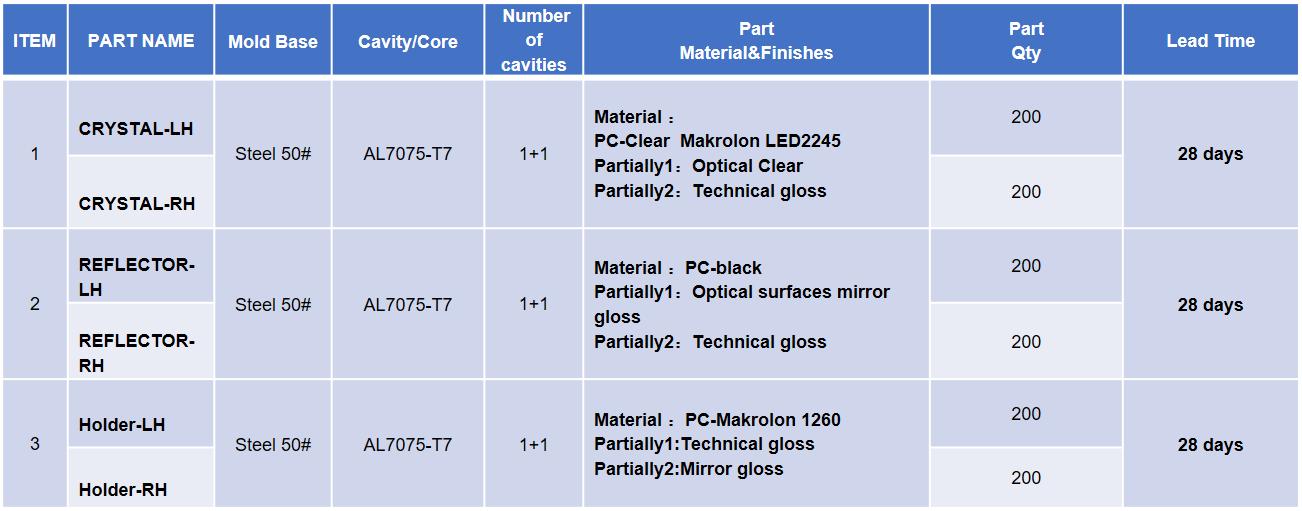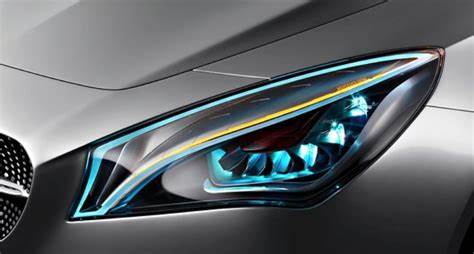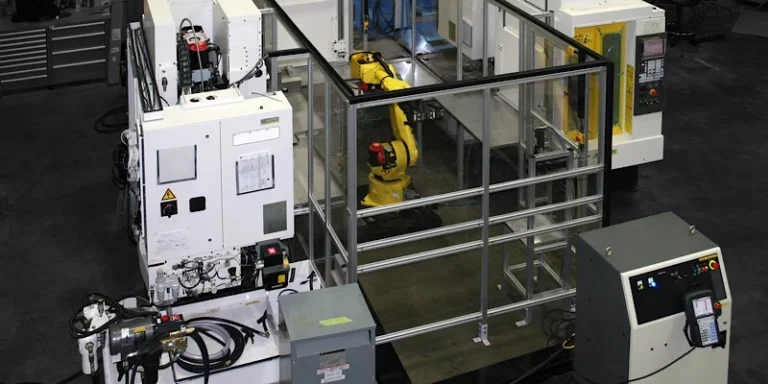Automotive lighting includes headlights, taillights, fog lamps, and more, each serving different purposes. As automotive lighting manufacturers, have you researched the effects of headlights? Do you understand the prototype manufacturing process during the car lamp design stage? AS Prototypes can provide the answers you need.
1. Design Requirements For Automotive Lighting
1.1 Headlamp
Car headlights, also known as car headlamps, are often referred to as the eyes of a vehicle. They not only contribute to the car’s external appearance but are also crucial for safe driving at night or in adverse weather conditions. The material used for headlights must ensure that the vehicle provides bright and steady illumination, allowing the driver to clearly see objects within 100 meters. Additionally, headlights must

Materials and performance requirements:
| Part Name | Production material | Prototype material | Property requirement |
| Lens | PC | PMMA、 PC | Scratch resistant, transparent, UV stable |
| Bezel | PC、PCHT、PBT、PBT/PET | PMMA 、ABS | Heat resistant, metalized, high surface quality |
| Lightguide | PC | PMMA 、PC | Transparent, UV stable |
| Reflector | PC、PBT、PPS、BMC | ABS 、Aluminium | High heat resistant, high rigidity, metalized, high impact resistant |
| Housing | PP+T40、PP+T20 | ABS | Dimensional stability, heat resistant |
1.2 Taillamp
The taillight serves as a signal light, conveying critical information such as braking and steering intentions. Given its frequent use in urban environments, the material used for taillights must meet high performance standards. It needs to possess high heat resistance, good processability, excellent wettability, and vibrant colors.
Materials and performance requirements:
| Part | Production material | Prototype material | Property requirement |
| Outer Lens | PMMA | PMMA PC | Scratch resistant, transparent, UV stable |
| Housing | ABS、PC/ABS、ASA | ABS | Dimensional stability, heat resistant |
| Inner Lens | PC、PCHT | PMMA PC | Transparent, UV stable |
| Frame | ABS | ABS | Dimensional stability |
| Lightguide | PC | PMMA PC | Transparent, UV stable |
1.3 Fog lamp
In conditions of low visibility, such as rain and fog, the effectiveness of standard headlights is limited. Fog lamps are designed to penetrate fog and other obstacles, ensuring a clear line of sight. Due to their high power and operating temperatures, the materials used for fog lamps must possess high heat resistance.
Materials and performance requirements:
| Part | Production material | Prototype material | Property requirement |
| Lens | PC + hard coating、PMMA | PMMA PC | Scratch resistant, transparent, UV stable |
| Housing | PCHT、PEI、PBT/ASA、LCP、PC/ABS | ABS | Dimensional stability, heat resistant |
| Reflector | PCHT、PEI、PC | ABS | High heat resistant, high rigidity, metalized, high impact resistant |
2. Automotive Lighting Prototype Manufacturing
Currently, the primary technologies used in the field of automotive lighting prototyping include 3D printing, CNC machining, silicone molding, and rapid aluminum molding, each offering distinct advantages. Based on AS Prototypes’ extensive experience in providing rapid prototyping services and automotive prototyping for the design and development of automotive lamps, the following outlines the different technical applications at various stages of development:
2.1 Concept and engineering stage:CNC machining
CNC headlamp prototype machining is characterized by high precision, fast response, and short production cycles (typically 1-2 weeks for delivery). This technology enables the machining of complex shapes from a single piece of material. During the concept stage and engineering design stage, it is often necessary to create appearance or functional models for parts of the headlight, such as light pipes or reflector cups. This demand requires the ability to produce high-precision prototypes in the shortest possible time using real materials, making CNC machining the best choice.
Due to the complex structure of automotive lamps, which include many optical details and undercuts, even high-precision 5-axis CNC machines cannot process the entire part in one go. CNC programming engineers with extensive experience in prototype lamp manufacturing must analyze the feasibility of machining upon receiving the lamp design drawings. For parts that cannot be processed integrally, they need to provide solutions for disassembly processing, especially for critical surfaces.
In the later stages of prototype production, post-processing tasks such as deburring, polishing, bonding, and painting are particularly important, as they directly determine the final appearance of the prototype.
2.2 Low volume testing stage: Silicon casting
Silicone molding is a straightforward method in rapid tooling, known for its good flexibility and replication performance, without the need for draft considerations. This technology is widely used for low-volume production of car lamps.
When producing low-volume headlamp parts using silicone molds, it is crucial to select the appropriate manufacturing methods and materials to meet the appearance and performance requirements of different parts.
For components like the lens and bezel, which require mirror polishing, we typically use CNC machining to create a prototype from PMMA, ensuring a high-quality surface finish. The silicone mold made from this prototype can guarantee the perfect appearance of the final casting.
For structural parts with fewer appearance requirements, such as the housing, we use rapid prototyping (RP) technologies like SLA to create the prototype and select AXSON PX223, known for its excellent temperature resistance, as the casting material.
3. Small Batch Loading Test: Aluminum Tool
Rapid mold materials primarily include soft steel (e.g., P-20) and aluminum (such as 7075 T-6 aerospace-grade aluminum). Compared to hard steel, these materials can increase processing speed by 15% to 30% and reduce polishing time by 3 to 10 times due to their lighter weight. This results in lower mold-making costs and shorter production cycles. Additionally, rapid aluminum tooling facilitates better temperature control, allowing for faster cycle times and reducing plastic stress.
During the car development stage, evaluating processing cycles and manufacturing costs is crucial, and rapid aluminum tooling provides these insights. Engineers can produce small batches of lamps using rapid aluminum tools for loading tests or early market launches. The biggest advantage of rapid aluminum tooling is that it uses real materials and structures, offering a fast reaction cycle while allowing reasonable and accurate evaluation of production cycles and costs. Below is the project cycle for AS Prototypes’ rapid taillight production using aluminum parts:
Compared to ordinary steel molds, aluminum molds can achieve almost the same surface quality. Although the lifespan of aluminum molds is related to product complexity and is generally lower than that of steel molds, they can still achieve a service life of no less than 1,000 cycles, which is sufficient for initial loading tests.
Below is an aluminum tool table for taillight parts:

Conclusion
The development and prototyping of automotive lighting, including headlights, taillights, and fog lamps, require careful consideration of material selection and manufacturing processes to ensure optimal performance and safety. Each type of light has specific requirements: headlights need bright and steady illumination with anti-glare features, taillights must be durable and vibrant, and fog lamps require high heat resistance to function effectively in low visibility conditions.
Advanced prototyping technologies such as CNC machining, 3D printing, silicone molding, and rapid aluminum tooling each offer unique advantages at different stages of development. CNC machining is ideal for creating high-precision prototypes quickly, while silicone molding is effective for low-volume production with excellent replication performance. Rapid aluminum tooling stands out for its ability to provide real material and structure, facilitating fast reaction cycles and accurate cost and production evaluations.
By leveraging these technologies, AS Prototypes ensures that automotive lighting prototypes meet stringent quality and performance standards, thereby supporting efficient development cycles and successful market launches.





